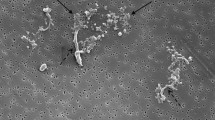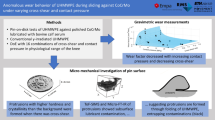Abstract
Counterface damage in the form of scratches, caused by bone cement, bone or metallic particles, has been cited as a cause of increased wear of ultra-high molecular weight polyethylene (UHMWPE) acetabular cups. It is known that high levels of particulate wear debris lead to osteolysis. Surface damage was characterized in a series of explanted Charnley femoral heads. The heads had a mean scratch height of 1 μm with a mean aspect ratio (defined as height divided by half width) of 0.1. Wear discs were artificially scratched using these scratch geometries as a guide. In addition, the scratch geometries were incorporated into a finite element model of a stainless steel asperity repeatedly sliding over UHMWPE under conditions similar to those in an artificial hip joint. Wear tests showed a strong correlation between the average cross-sectional area of the scratch lip above the mean zero line and the measured wear factor. The finite element model predicted increases in the area of UHMWPE suffering plastic strain with increases in the cross-sectional area of the asperity above the mean line. Analysis of the wear debris showed the mode of the particle size was 0.01–0.5 μm for all cases. The morphology of the particles varied with aspect ratio of the asperity, with an increased percentage mass of submicrometer-sized debris with increased scratch lip aspect ratio. The finite element results predicted that the maximum surface strains would increase with increasing asperity aspect ratio. Examination of the worn UHMWPE pin surfaces showed an association between increased surface damage, probably due to high surface strains, and increased aspect ratio. The large areas of surface plastic strain predicted for asperities with high cross-sectional areas above the mean line offer an explanation for the positive correlation between wear rate and the average cross-sectional area of the scratch lip material. The higher surface strains predicted for the higher aspect ratios may explain the increased percentage mass of biologically active submicrometer-sized wear particles found for scratch lips with higher aspect ratios. ©©2000 Kluwer Academic Publishers
Similar content being viewed by others
References
H. AMSTUTZ, P. CAMPBELL, N. KOSSOVSKY and I. CLARKE, Clin. Ortho. Rel. Res. 276 (1992) 7.
J. CHIBA, W. MALONEY, M. HORIKOSHI, L. MCINTYRE and H. RUBASH, in “Proceedings of the 39th Annual Meeting of the Orthopaedic Research Society”, Vol. 22–2 (1997) p. 270.
T. GREEN, J. FISHER and E. INGHAM, in “Transactions of the 42nd Annual Meeting of the Orthopaedic Research Society”, (Orthopaedic Research Society, 1997) p. 733.
A. SHANBHAG, J. JACOBS, T. GLANT, J. L. GILBERT, J. BLACK and J. O. GALANTE, J. Bone Joint Surg. 76-B (1994) 60.
P. CAMPBELL, S. MA, B. YEOM, H. A. MCKELLOP, T. P. SCHMALZREID and H. C. AMSTUTZ, J. Biomed. Mater. Res. 29 (1995) 127.
J. L. HAILEY, E. INGHAM, J. FISHER, D. DOWSON and B. M. WROBLEWSKI, in “Proceedings of the 11th European Conference on Biomaterials”, (1994) pp. 321–3.
K. KATO, in “New Directions in Tribology”, edited by I. M. Hutchings (MEP, London, 1997).
J. L. HAILEY, E. INGHAM, M. STONE, B. M. WROBLEWSKI and J. FISHER, Proc. Inst. Mech. Eng. Part H 210 (1996) 3.
J. FISHER, Current Orthopaedics 8 (1994) 164.
J. A. ESTUP INAN, D. L. BARTEL and T. M. WRIGHT, in “Transactions of the 42nd Annual Meeting of the Orthopaedic Research Society”, (Orthopaedic Research Society, 1996) pp. 48–8.
C. M. MCNIE, D. C. BARTON, M. H. STONE and J. FISHER, J. Eng. Med. 212 (1998) 49.
J. FISHER, D. DOWSON, H. HAMDZAH and H. LEE, Wear 175 (1994) 219.
J. H. DUMBLETON in “Tribology of Natural and Artificial Joints”, (Elsevier, New York, 1981) p. 50.
J. L. TIPPER, E. INGHAM, J. L. HAI LEY, A. A. BESONG, M. STONE, B. M. WROBLEWSKI and J. FISHER, in “Transactions of the 43rd Annual Meeting of the Orthopaedic Research Society”, Vol. 22–1 (Orthopaedic Research Society, 1997) p. 355.
R. R. SOKAL and F. J. ROHLF, in “Biometry”, (W. H. Freeman, New York, 1995) p. 244.
Idem.,ibid. p. 560.
HIBBET, KARLSSON, SORENSEN, INC., ABAQUS Standard/ User's Manual, Version 5.4 (1994).
L. CARAVIA, D. DOWSON, J. FISHER and B. JOBBINS, Proc. Inst. mech. Eng. Part H 204 (1990) 65.
M. JASTY, C. R. BRAGDON, K. LEE, A. HANSON and W. H. HARRI S, J. Bone Joint Surg. 76-B (1994) 73.
J. R. COOPER, D. DOWSON and J. FISHER, Wear 162–164 (1993) 378.
J. FISHER, P. F IRKINS, E. A. REEVES, J. L. HAILEY and G. H. ISSAC, Proc. Inst. Mech. Eng. Part H 209 (1995) 263.
J. K. LANCASTER, in “Friction and Wear”, edited by A. D. Jenkins (North Holland, 1972) pp. 960–1046.
A. WANG, V. K. ESSNER, D. C. SUN, C. STARK and J. H. DUMBLETON, in “New Directions in Tribology”, edited by I. M. Hutchings (MEP, London, 1997) pp. 443–58.
J. DOWLING, J. R. ATKINSON, D. DOWSON and J. CHARNLEY, J. Bone Joint Surg. 60-B (1978) 375.
J. R. COOPER, D. DOWSON and J. FISHER, Wear 151 (1991) 391.
L. M. KEER, Y. XU, H. S. CHANG and J. L. XUAN, Tribology Trans. 36 (1993) 613.
Author information
Authors and Affiliations
Rights and permissions
About this article
Cite this article
Mcnie, C.M., Barton, D.C., Ingham, E. et al. The prediction of polyethylene wear rate and debris morphology produced by microscopic asperities on femoral heads. Journal of Materials Science: Materials in Medicine 11, 163–174 (2000). https://doi.org/10.1023/A:1008979608563
Issue Date:
DOI: https://doi.org/10.1023/A:1008979608563




